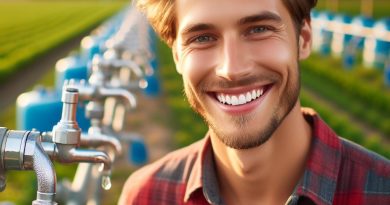Water-Saving Tips for Farmers in Drought
Last Updated on March 2, 2024
Introduction
Let’s Explore Water-Saving Tips for Farmers in Drought
A. The importance of water conservation in farming during drought
Water is a precious resource, especially for farmers during times of drought.
Conserving water becomes vital for the sustainability and productivity of their farms.
According to recent statistics, water scarcity has a significant impact on agriculture, with over 70% of freshwater resources consumed in farming activities globally.
The consequences of water scarcity include reduced crop yields, loss of livestock, and increased financial burdens on farmers.
In this blog post, we will focus on providing practical tips and techniques for farmers to save water during droughts.
These tips are designed to help farmers mitigate the effects of water scarcity and maintain the health of their crops and livestock.
By implementing these strategies, farmers can optimize their water usage while minimizing wastage.
B. Purpose of the blog post
The blog post will cover a range of water-saving techniques, including efficient irrigation methods, implementing soil moisture monitoring systems, practicing water-smart crop selection, and promoting sustainable water management practices.
Each tip will be accompanied by a brief explanation of its benefits and instructions on how to implement it effectively.
By adopting these water-saving strategies, farmers can not only adapt to drought conditions but also contribute to the conservation of our precious water resources.
The forthcoming sections of this blog post will delve into each technique, providing farmers with practical guidance to implement sustainable water practices during periods of drought.
Let’s dive in and explore these valuable tips to help farmers thrive even in the face of water scarcity.
Understanding Water Usage on Farms
A. The typical water usage patterns on farms
Manually watering crops and animals can be labor-intensive and time-consuming.
Moreover, it may lead to inefficient water usage, resulting in water loss through evaporation or runoff.
Drip irrigation systems answer this challenge by delivering water directly to the crop’s root zone, maximizing its absorption and minimizing waste.
Through this method, water is applied more efficiently, reducing overall water consumption on farms.
Furthermore, advanced technologies such as soil moisture sensors and weather-based irrigation controllers can optimize irrigation scheduling.
By collecting data on soil moisture levels and weather forecasts, farmers can adjust irrigation timing and amounts.
This targeted approach ensures that crops receive adequate water only when needed, avoiding overwatering.
B. Areas where water is commonly used in agriculture
In addition to irrigation, livestock watering is another crucial area to consider for water conservation.
Implementing automated watering systems helps ensure that livestock receive adequate hydration without excessive water wastage.
These systems can be equipped with sensors to control water flow based on the animals’ drinking patterns, minimizing water runoff.
Cleaning equipment and maintaining proper sanitation practices are vital for farm operations.
However, it is essential to find ways to reduce water usage during these activities.
For instance, using high-pressure, low-volume nozzles for equipment cleaning can optimize water efficiency by minimizing water waste.
Furthermore, implementing water recycling systems allows farmers to reuse water for cleaning purposes, reducing freshwater consumption.
C. Importance of analyzing water usage to identify potential areas for conservation
Analyzing water usage can also uncover potential leakages or inefficiencies in the water supply system.
By promptly identifying and repairing leaks, farmers can prevent water loss and conserve this valuable resource.
Regular inspections of irrigation infrastructure and plumbing systems are crucial for detecting such issues.
To encourage farmers to analyze their water usage, various governmental and non-governmental organizations provide support and incentives.
These efforts aim to raise awareness about water conservation in agriculture and provide resources for implementing efficient practices.
Through education and financial assistance programs, farmers can access tools, training, and funding to adopt water-saving technologies and conservation measures.
Therefore, understanding water usage patterns on farms is essential for effective water conservation.
By analyzing usage in areas such as irrigation, livestock watering, and equipment cleaning, farmers can identify opportunities to save water.
Implementing technologies like drip irrigation systems, automated livestock watering, and water recycling can significantly reduce water consumption.
Additionally, regular inspections and prompt repair of leakages contribute to preserving this valuable resource.
Governmental and non-governmental support further aids farmers in adopting water-saving practices for a sustainable farming future.
Read: Climate Impact: Protecting Our Farms
Water-Saving Strategies for Irrigation
A. Importance of efficient irrigation systems
Efficient irrigation systems are crucial for water conservation on farms.
They ensure that water is used wisely, reducing waste and maximizing crop yield.
B. Different types of irrigation methods and their pros and cons in terms of water conservation
- Sprinkler Irrigation: Sprinklers distribute water over the crops, but they can be wasteful due to evaporation and wind drift.
- Flood Irrigation: This method floods the fields with water, but it is inefficient as a large amount of water is lost to evaporation and runoff.
- Drip Irrigation: Drip irrigation delivers water directly to the roots of plants, resulting in minimal water loss and better water efficiency.
- Furrow Irrigation: In furrow irrigation, water is diverted into furrows between crop rows, which can lead to significant water loss through evaporation.
C. Tips for proper irrigation scheduling to avoid water waste
- Monitor soil moisture regularly to determine the water needs of crops.
- Consider factors such as weather conditions, plant growth stages, and soil type in irrigation scheduling.
- Water crops during the early morning or late evening to minimize evaporation losses.
- Avoid over-irrigation as it can lead to waterlogging and nutrient leaching.
D. Benefits of using drip irrigation or other precision irrigation techniques for water efficiency
Drip irrigation is highly efficient, delivering water directly to plant roots while minimizing water loss through evaporation and runoff.
Other precision irrigation techniques, such as micro-sprinklers and pivot systems, also offer similar benefits.
The benefits of using these techniques include:
- Reduced water consumption through precise water application.
- Savings in energy and labor costs due to efficient irrigation systems.
- Improved crop yield and quality, as water is supplied where it is needed the most.
- Prevention of soil erosion and nutrient leaching by applying water directly to the root zone.
- Minimal weed growth and reduced need for herbicides, as water is targeted to crops only.
By implementing these water-saving strategies for irrigation, farmers can contribute to the conservation of water resources while ensuring the sustainable production of crops.
Read: Changing Seasons, Changing Harvests: US Focus
Managing Livestock Watering
A. The critical role of providing water to livestock during drought
- Livestock depend on water for survival and maintaining their overall health.
- Water helps with digestion and nutrient absorption in animals.
- Adequate hydration is essential for milk production in dairy cattle.
- Lack of water during drought can lead to weight loss, decreased fertility, and even death in livestock.
B. Strategies for minimizing water waste while ensuring animals’ hydration needs are met
- Install automatic watering systems to control water flow and avoid excessive water usage.
- Utilize water troughs with properly fitted lids to prevent evaporation.
- Implement rotational grazing to give pastures time to recover and reduce water demands.
- Use water-efficient irrigation methods, such as drip or pivot systems, for forage production.
C. Methods of improving water quality for livestock to reduce water consumption
- Regularly clean water troughs and remove debris to prevent bacterial growth.
- Consider installing water filtration systems or using chemical treatments to improve water quality.
- Provide access to clean and fresh water sources, such as natural springs or deep wells.
- Implement proper manure management practices to prevent contamination of water sources.
D. The importance of regularly checking for leaks or inefficient water delivery systems in the animal watering infrastructure
- Leaks can lead to water loss and wasted resources during drought conditions.
- Inspect pipelines, hoses, and valves for any signs of leaks or damage.
- Repair or replace faulty equipment promptly to prevent further water loss.
- Monitor water pressure to ensure optimal flow and prevent overconsumption by livestock.
By effectively managing livestock watering during drought, farmers can ensure the well-being of their animals while conserving water resources.
Providing adequate water supply to livestock is crucial for their survival, health, and productivity.
Strategies like installing automatic watering systems, using water-efficient irrigation methods, and practicing rotational grazing can minimize water waste while meeting the hydration needs of animals.
Furthermore, improving water quality through regular cleaning, filtration, and proper manure management can reduce overall water consumption by livestock.
Regularly checking for leaks and maintaining efficient water delivery systems is essential.
Leaks can lead to significant water loss, especially in times of drought when water resources are already limited.
Farmers should inspect their pipelines, hoses, and valves for any signs of leaks or damage.
Prompt repairs or replacements should be done to prevent further water loss.
Monitoring water pressure also ensures optimal flow and prevents overconsumption by livestock.
Overall, managing livestock watering during drought requires a holistic approach that combines water conservation, animal welfare, and regular infrastructure maintenance.
By implementing these strategies, farmers can make a significant impact in minimizing water waste and ensuring the sustainability of their agricultural operations even during challenging climatic conditions.
Read: Crops & Floods: Navigating the Risks

Enhancing Farm Equipment Cleaning Practices
In drought-stricken regions, conserving water is paramount for sustainable agriculture.
Farm equipment, essential for crop cultivation, requires thorough cleaning for efficient operation.
Here’s how farmers can enhance their cleaning practices while minimizing water usage.
A. Why Clean Farm Equipment Matters
- Dirt and debris hinder equipment performance.
- Clean machinery ensures optimal functioning.
- Efficiency boosts productivity during drought conditions.
Dirty equipment compromises performance, hindering productivity during crucial times like droughts.
By maintaining clean machinery, farmers optimize operational efficiency, ensuring every drop of water counts towards sustaining their crops.
B. Best Practices for Water-Efficient Cleaning
- Use brooms or compressed air for initial debris removal.
- Target high-pressure, low-volume washing for thorough cleaning.
- Employ biodegradable detergents to minimize environmental impact.
Begin by manually removing debris with brooms or compressed air.
Then, utilize high-pressure, low-volume washing techniques for thorough cleaning.
Opt for biodegradable detergents to minimize environmental impact while achieving cleanliness.
C. Exploring Alternative Cleaning Methods
- Consider dry cleaning techniques for minimal water usage.
- Utilize pressure washers with water-saving features.
- Implement steam cleaning where feasible to conserve water.
Innovative approaches like dry cleaning reduce water usage significantly.
Additionally, employing pressure washers with water-saving features proves beneficial.
Where applicable, steam cleaning offers an effective alternative, conserving water resources.
D. Promoting Regular Equipment Maintenance
- Inspect equipment routinely to detect leaks early.
- Fix leaks promptly to prevent water wastage.
- Scheduled maintenance prevents malfunctions and reduces water consumption.
Regular inspections are crucial for detecting leaks early.
Timely repairs prevent water wastage, preserving this precious resource.
Scheduled maintenance not only prevents malfunctions but also contributes to water conservation efforts on farms.
By adopting these water-saving tips, farmers can maintain efficient equipment cleaning practices, even in drought conditions.
Every effort counts towards preserving water resources for future generations while sustaining agricultural productivity.
Read: Climate Smart Farming: What’s New?
Learn More: Water-Saving Innovations in Farming
Maximizing Rainwater Harvesting Opportunities
In times of drought, water scarcity becomes a pressing issue for farmers, affecting their crops and livelihoods.
One effective solution to combat this problem is rainwater harvesting.
This section explores the benefits of rainwater harvesting, various collection methods, proper storage and filtration systems, as well as real-life success stories.
A. Benefits of Rainwater Harvesting for Farmers during Drought
- Reduces dependency on freshwater sources, ensuring a sustainable water supply for agricultural needs.
- Lower costs associated with pumping groundwater or purchasing municipal water.
- Minimizes soil erosion and nutrient depletion by providing natural irrigation.
- Offers an alternative during drought periods when rainfall is insufficient for conventional irrigation.
- Promotes self-sufficiency and resilience, enabling farmers to maintain productivity even in challenging conditions.
B. Different Rainwater Collection Methods Applicable to Farming Settings
- Rooftop Catchment: Utilize roofs’ surface area to capture rainwater, directing it into storage containers or reservoirs.
- Surface Runoff Harvesting: Construct trenches, swales, or ponds to collect and retain rainwater runoff from fields.
- Contour Bunds: Create raised barriers along the contour lines of a field to impede water flow and facilitate infiltration.
- Micro-Catchments: Construct small structures around individual plants to capture rainwater specifically for their needs.
- Diversion Channels: Divert excess rainwater from rivers or streams into designated storage facilities.
C. Guidance on Proper Rainwater Storage and Filtration Systems
- Use clean and non-toxic storage containers such as underground tanks, ponds, or barrels with tight lids.
- Ensure proper installation of gutters, downspouts, and filters to prevent debris from entering the collection system.
- Consider implementing first-flush devices to divert initial runoff containing dust, pollutants, and bird droppings.
- Install filtration systems like sand filters, mesh screens, or sedimentation tanks to improve water quality.
- Regularly clean and maintain the storage and filtration systems to prevent contamination and blockages.
D. Success Stories of Farmers Utilizing Rainwater Harvesting Effectively
Real-life examples inspire and encourage other farmers to adopt rainwater harvesting methods:
- Smith Brothers Farm: By constructing rooftop catchment systems, they reduced water costs by 40%.
- Greenleaf Vineyards: Implementing surface runoff harvesting improved irrigation, resulting in a 20% yield increase.
- Maple Grove Orchard: Micro-catchments provided targeted watering, leading to healthier fruit trees and a 30% higher harvest.
- Jackson Farm: Diversion channels were used to collect excess rainwater, supporting irrigation during dry spells.
Rainwater harvesting empowers farmers to overcome the challenges posed by drought conditions, preserving their crops and sustaining their livelihoods.
By understanding the benefits, utilizing appropriate collection methods, and implementing proper storage and filtration systems, farmers can maximize water availability and ensure the health and productivity of their farms.
Utilizing Technology for Water Management
A. The advancements in agricultural technology related to water conservation
Advancements in agricultural technology have paved the way for more efficient water management on farms.
With the ever-increasing concern over drought and limited water resources, it has become crucial for farmers to explore these technologies to conserve water effectively.
B. Role of remote sensing, soil moisture monitoring, and other tools in optimizing water usage
One of the key technologies that have revolutionized water management in agriculture is remote sensing.
This technology allows farmers to monitor their fields from a distance and gather crucial data on water distribution and crop health.
Using satellite imagery and drones, farmers can detect variations in soil moisture levels and identify areas that require more water or even determine which fields are at risk of drought stress.
This allows for targeted irrigation, minimizing water wastage and maximizing crop yield.
In addition to remote sensing, soil moisture monitoring plays a vital role in optimizing water usage.
By constantly monitoring soil moisture levels, farmers can determine the exact amount of water required by their crops.
Soil moisture sensors embedded in the ground provide real-time data, helping farmers make informed decisions about irrigation scheduling and ensuring that water is used efficiently.
C. Benefits of using irrigation scheduling apps or smart controllers to improve water management
Integrating irrigation scheduling apps or smart controllers into farming practices can greatly improve water management.
These apps use advanced algorithms to analyze weather forecasts, soil conditions, and crop water needs to create customized irrigation schedules.
By automating the irrigation process, farmers can avoid over-watering and under-watering, resulting in significant water savings.
The benefits of using such technologies are manifold.
Firstly, water-saving technologies help farmers reduce their reliance on groundwater sources and alleviate pressure on local water supplies.
This is essential in times of drought when water scarcity becomes a pressing issue.
Secondly, by optimizing water usage, farmers can improve the overall efficiency of their irrigation systems and achieve better crop yields.
This not only boosts their productivity but also contributes to food security.
D. Available government programs or grants that support farmers in adopting water-saving technologies
Furthermore, governments have recognized the importance of promoting water-saving technologies in agriculture and have introduced various programs and grants to support farmers in adopting these technologies.
These initiatives aim to incentivize farmers to invest in water-saving equipment and technology.
By offering financial assistance or subsidies, governments hope to encourage widespread adoption of these practices, ultimately benefiting the environment and the farming community.
For example, the United States Department of Agriculture (USDA) provides grants under the Environmental Quality Incentives Program to help farmers implement water conservation practices.
These grants can cover a portion of the costs associated with the installation of irrigation scheduling apps, smart controllers, or soil moisture sensors.
Similar programs are also available in other countries, acknowledging the importance of water-saving technologies in ensuring sustainable agriculture.
In short, the advancements in agricultural technology related to water conservation have significantly improved water management on farms.
Remote sensing, soil moisture monitoring, and irrigation scheduling apps are just a few examples of the technologies that farmers can utilize to optimize water usage.
These technologies not only save water but also enhance crop yields and promote sustainable agriculture.
Additionally, governments play a crucial role in supporting farmers by offering programs and grants to encourage the adoption of water-saving technologies.
By embracing these advancements, farmers can navigate the challenges of drought and contribute to a more sustainable future for agriculture.
Conclusion
The significance of water-saving practices in agriculture during drought cannot be overstated.
As water scarcity continues to challenge farmers worldwide, adopting efficient irrigation methods and conservation techniques becomes imperative.
Throughout this blog post, we have explored various strategies to mitigate the impact of drought on farming operations.
Recapping the key tips discussed, farmers are encouraged to implement drip irrigation systems to deliver water directly to plant roots, minimizing wastage.
Additionally, utilizing soil moisture sensors helps optimize watering schedules, ensuring plants receive adequate hydration without excess usage.
Incorporating mulching techniques retains soil moisture and reduces evaporation, while crop rotation and cover crops promote soil health and water retention.
Farmers are urged to embrace these water-saving practices not only to sustain crop yields during drought but also to contribute to the overall resilience of agricultural systems.
By conserving water resources and adopting sustainable farming methods, they play a vital role in ensuring food security and environmental stewardship for future generations.
Embracing these practices fosters a more resilient and sustainable agricultural sector, safeguarding livelihoods and ecosystems in the face of water scarcity challenges.


